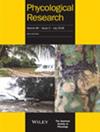Asterocladon ednae sp. nov. (Asterocladales, Phaeophyceae) from the Philippines
IF 1
4区 生物学
Q2 MARINE & FRESHWATER BIOLOGY
引用次数: 2
Abstract
Members of the brown algal order Asterocladales are characterized by stellate arrangement of its chloroplasts, in which a stellate configuration has a protruding central pyrenoid complex. The order is represented by the genus Asterocladon, which consists of only three species so far. Similar to other small and filamentous seaweeds, studies on Asterocladon remain scant and their diversity poorly understood. To fill this gap, we conducted molecular‐assisted taxonomic studies on Asterocladon based on seven culture isolates collected from Okinawa Prefecture, Japan and Cebu, the Philippines. One culture isolate from the Philippines was revealed to be a new species of Asterocladon based on morpho‐anatomical and molecular analyses using rbcL and psaA genes and is described here as Asterocladon ednae. The other isolates were attributed to A. rhodochortonoides. A. ednae was most closely related to A. rhodochortonoides in morphology and molecular phylogeny but was distinguished from the latter by its elongately ellipsoid plurilocular sporangia. This is the first report of the genus and species A. ednae in the Philippines, further increasing the diversity of seaweeds in the country.产自菲律宾的星形cladon ednae sp. 11 .(星形cladales, phaophyceae)
褐藻目Asterocladales的成员的特征是其叶绿体的星状排列,其中星状结构具有突出的中央蛋白核复合体。该目以Asterocladon属为代表,迄今为止该属仅由三个物种组成。与其他小型丝状海藻类似,对Asterocladon的研究仍然很少,对其多样性的了解也很少。为了填补这一空白,我们基于从日本冲绳县和菲律宾宿务收集的七个培养分离株,对Asterocladon进行了分子辅助分类研究。根据rbcL和psaA基因的形态解剖和分子分析,一个来自菲律宾的培养分离物被发现是Asterocladon的一个新种,在这里被描述为Asterocladon-ednae。其他分离株均归属于杜鹃花。A.ednae在形态和分子系统发育上与A.rhodochoronoides亲缘关系最为密切,但与后者的区别在于其细长的椭球多室孢子囊。这是菲律宾首次报告A.ednae属和物种,进一步增加了该国海藻的多样性。
本文章由计算机程序翻译,如有差异,请以英文原文为准。
求助全文
约1分钟内获得全文
求助全文
来源期刊

Phycological Research
生物-海洋与淡水生物学
CiteScore
3.60
自引率
13.30%
发文量
33
审稿时长
>12 weeks
期刊介绍:
Phycological Research is published by the Japanese Society of Phycology and complements the Japanese Journal of Phycology. The Journal publishes international, basic or applied, peer-reviewed research dealing with all aspects of phycology including ecology, taxonomy and phylogeny, evolution, genetics, molecular biology, biochemistry, cell biology, morphology, physiology, new techniques to facilitate the international exchange of results. All articles are peer-reviewed by at least two researchers expert in the filed of the submitted paper. Phycological Research has been credited by the International Association for Plant Taxonomy for the purpose of registration of new non-vascular plant names (including fossils).
 求助内容:
求助内容: 应助结果提醒方式:
应助结果提醒方式:


